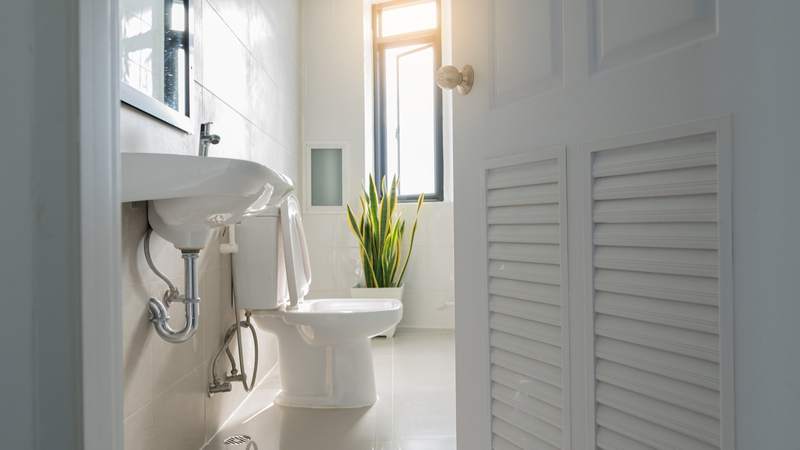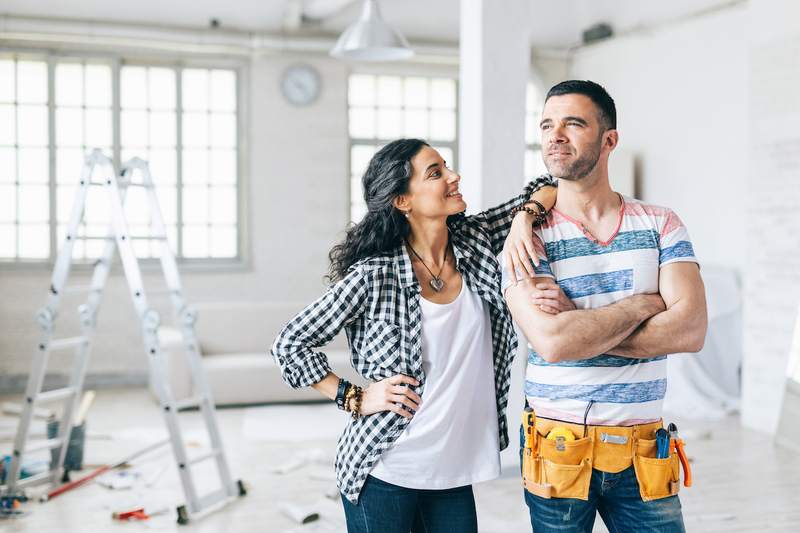A half bathroom can be an effective way to utilize the footprint of your home and increase your property value. But it might not be clear what qualifies as a half bath, so take the time to understand what it is before you start planning an addition to your home.
Here’s what you need to know about half baths in real estate:
- What Is a Half Bath?
- Elements of a Full Bathroom
- Other Types of Bathrooms
- Benefits of a Half Bath
- Drawbacks of a Half Bath
- Where To Add a Half Bath
- How To Build a Half Bath
- Cost of Building a Half Bath
- How To Finance a Half Bath
- Half Bath FAQ
- The Bottom Line on Half Baths
What Is a Half Bath?
A half bath is defined as a bathroom that has a toilet and a sink or vanity but neither a shower nor a bathtub. It contains two of the four elements of a full bath, with the key components being the sink and toilet. It’s uncommon — and poor design — to add a shower and a sink and call the room a half bath.
Typically, you’ll find half baths on the ground floor of a home. They’re usually for guests to use, while full bathrooms are located near bedrooms and for people who live in the home.
Elements of a Full Bathroom
A full bathroom contains four key components: a toilet, a sink or vanity, a shower, and a bathtub.
Toilet
Toilets are typically cheap, costing about $100 or $200 for basic models, and take up relatively little space. A traditional two-piece toilet measures about 33 inches high, 18 inches wide, and 30 inches deep. You also could consider using a single-piece toilet if you want to save more space.
Sink or vanity
A sink or vanity provides an essential place for people to wash their hands.
Wall-mounted sinks can cost less than $100 and take up about 18 inches of space from front to back. Pedestal sinks look nicer but are pricier, costing about $200 or more.
A vanity typically includes a sink, a countertop, and a mirror, and is more common in a full bath than a half bath. Vanities are larger than wall-mounted or pedestal sinks, ranging from 30 to 60 inches wide. They also cost more. Expect to spend $250 to $350 or more on a vanity top, excluding the cost of a mirror.
Shower
A shower takes up far more space than a toilet or sink, and can be more expensive. A basic shower stall costs around $350, but nice ones can cost $1,000 or more.
The typical footprint for a stall is 32 inches wide, 32 inches deep, and 74 inches high. However, shower measurements can vary. For example, for a shower to be compliant with the Americans with Disabilities Act, it must have a rectangular seat near the opening of the stall that is at least 24 inches by 16 inches.
Bathtub
There are many different types of bathtubs, including walk-in tubs, corner tubs, free-standing tubs, alcove tubs, and bathtub and shower combinations. The size and price will depend on the type of tub, as well as its design, quality, and features.
A basic alcove tub can start as low as $300 but cost twice as much or more. Alcove tubs are typically 60 inches by 20 inches. Free-standing tubs are around the same size but typically start at about $600 and can cost up to $2,000 or more.
Many homeowners opt for bathtub and shower combos in their main bathroom. These are typically similar in size to basic tubs but cost about $700 to $800.
Other Types of Bathrooms
In addition to half baths and full baths, you can divide bathrooms in other ways to serve different purposes.
Three-quarter bathroom
Three-quarter bathrooms are less common than half baths. They’re usually bigger than a half bath but smaller than a full bath, and typically feature a toilet, a sink, and a shower with no bathtub. Three-quarter baths are popular near guest bedrooms because they give people a private space to wash up without dedicating the square footage required for a full bath.
Quarter bathroom
Quarter bathrooms are relatively uncommon to find in a home. They’re typically a feature of tiny homes or older properties.
A quarter bath sometimes has just a toilet, skipping out on the shower, bathtub, and even sink. It takes up very little space but functions best when located near a kitchen or other sink so people can wash their hands.
In some cases, a quarter bath can take the form of an outdoor shower on a beachfront property, or a shower near a pool to wash off before or after a swim.
Benefits of a Half Bath
Half bathrooms are popular because there can be many advantages to adding one to your home.
Future conversion to a three-quarter bath or full bath
Half baths can be expanded into a three-quarter bath or a full bath. The plumbing for a new bathroom project can cost as much as $10,000, so converting a half bath to a larger bathroom could help you save money and time. There’s already a nearby pipe network to support the new shower or bathtub.
Can add value to your home
Making home improvements can increase your property value, which boosts your home equity. Half baths are a relatively cost-effective addition when it comes to translating the price of the upgrade into home value. A half bath can boost your home’s value by about 55% of the installation cost — meaning a $5,000 to $15,000 increase in value.
Functional and efficient use of space
Half baths have a small footprint because you only need room for a sink and a toilet. That makes half baths a great way to get more use out of a space in your home that isn’t big enough for much else.
“Half baths or powder rooms are a great way to add functionality and style to any living space,” says Jason Farr, an interior designer and founder of the San Diego-based construction company Aviara Pavers. “The primary benefit of adding a half bath is that it saves time and energy for people living in the home, as well as visitors.”
Drawbacks of a Half Bath
It’s important to know the limitations of half baths.
Limited space
Though the small footprint of a half bath can be a benefit, its size can also be a drawback. This may be an issue for larger households in particular. Adding a half bath, for example, won’t help if your family is frequently fighting over who gets to shower first in the morning.
“Half baths may not be ideal for larger households as they are often too small to adequately serve everyone,” says Raf Michalowski, a New York-based interior designer and CEO of Meble Furniture. “It can also be difficult to add fixtures or make any significant changes, as there is limited space.”
Missing elements of a full bath
Half baths don’t have a shower or a bathtub, so their only uses are washing up and using the toilet. If you’re having guests over frequently or growing your family, and you want another space to bathe, then a half bath won’t solve that problem.
Expensive to build
Half baths are less expensive than full baths — but not by a lot.
The primary cost is plumbing. If you’re lucky enough to be able to use existing plumbing, then a half bath might cost as much as $5,000. But if you need to run new pipes, then the price could easily get close to $20,000.
On top of that, you need to consider permit costs. A half bath isn’t the type of addition you can make without a permit and an inspection.
Insurance and tax liability
“Adding a half bath to a home can potentially impact taxes and insurance,” Farr says. “In some areas, this would result in an increase in property value, which can lead to higher property taxes. You should also be sure to check with your insurance provider to see if you need an additional policy or increased coverage for the updated space.”
Where To Add a Half Bath
If you’re considering a half bath, these are some good places to make the addition to your home.
Hallway
A hallway is a good place to add a half bath because it’s typically accessible and near important rooms in the home. Half baths don’t require much room, so you should be able to find space off a hallway to add one.
Closet
A closet is about the right size for a half bath, which means it could be a good location. You won’t need to add a new room or build walls. Closets are also commonly located in areas where a half bath would be useful, such as guest rooms or near the front door.
Garage
Garages often have unused space that can get converted into a half bath. This could provide easy access to a bathroom while you’re working in the garage. If the garage is attached, then you could make it accessible from inside your home as well.
Depending on the plumbing in your home, you may already have pipes in or near the garage — such as to feed an outdoor water spigot — which could make the addition less expensive.
Under a staircase
The space under a staircase is typically just big enough to fit a half bath. That means these spots can be a good place to add a half bath and create useful square footage out of your home’s footprint.
How To Build a Half Bath
Adding a half bath to your home is a multistep process. Using these tips can help it go smoothly.
1. Find a contractor
Adding a bathroom can involve building or removing walls, updating electrical systems, working on plumbing, fixing flooring, and other tasks, so you’ll want to find a general contractor that can help.
“Generally, the first step is to contact a professional who can assess your space and provide an estimate of the cost,” Michalowski says.
Do your due diligence and talk to a few contractors. Get quotes and check their reviews to make sure you’re working with someone experienced and trustworthy.
2. Choose a plan
Work with your contractor to determine the best plan for a new half bath in your home. You probably already have an idea of where you want to put the addition, so ask them to draw up one or two floor plans for how it will look. You can also ask if they see a better spot to put the half-bath.
3. Prepare the site
Once you know where the half bath will go, you’ll need to prepare the site. Remove furniture, wall decor, and anything else that could get in the way of construction, and let the contractors get to work.
4. Renovate
Once you’ve chosen a contractor and a plan and prepared the site, it’s time to wait. The average half-bath renovation will take about three weeks once work begins.
Cost of Building a Half Bath
Half baths can vary significantly in price. The two biggest costs for adding a half bath are the plumbing and electrical requirements.
“The cost of installing a half bath will vary depending on the size, materials used, labor costs, and other factors. Generally speaking, adding a half bath can start at around $2,000,” Farr says. “However, it is not uncommon for some projects to cost upwards of $10,000 or more. Be sure to get several estimates from different contractors before making a decision.”
Plumbing
A bathroom needs to have plumbing to bring water in and out of the room. If you have nearby pipes you can extend to the half bath, then you’ll save a lot of money. If you need to run a new set of pipes, then you could easily spend $10,000 or more on plumbing alone.
Electrical
Bathrooms need electrical connections for lighting and outlets. Because they will be close to water sources, you must comply with specific safety requirements during installation. This is standard in new homes, but older homes may require more extensive upgrades.
Flooring
You’ll likely want to floor your bathroom with tile, vinyl, linoleum, or a similar material. Depending on the flooring you choose, expect to pay between $1 and $10 per square foot for the material and between $3 and $10 per square foot for the labor. For a half bath that’s 40 square feet, that means paying a minimum of between $160 and $800 for the materials and labor.
Fees and permits
Your local government will most likely require a permit and inspection when you add a half bath. The cost of fees and permits will vary depending on where you live.
For example, Malden, Massachusetts, charges a minimum $40 fee for home alterations and $50 plus $5 per fixture for plumbing. Concord, New Hampshire, charges $30 plus $7.60 per $1,000 of the estimated cost and 10 cents per square foot of gross area involved for home alterations, and $30 plus additional fees based on fixtures and pipe length for plumbing.
Check with your local government to get an idea of how much you’ll pay for permits.
Insurance and taxes
You may want to buy additional insurance coverage once the renovation is complete and your home’s value has increased. You should also budget for higher property taxes based on your home’s new value.
How To Finance a Half Bath
If you can’t afford to pay outright for a half bath, you can consider financing the project. There are a few ways to do this.
Home equity loan
A home equity loan lets you tap into your home’s value and borrow a lump sum. If you have sufficient equity, this can be a great way to borrow a large amount of cash at a relatively low interest rate.
HELOC
Home equity lines of credit allow for more flexibility than home equity loans, and they share many of the same advantages. While home equity loans offer a lump sum, HELOCs let you draw funds from a line of credit on an as-needed basis. The drawback of a HELOC is that it typically has a variable interest rate, which means your payments could get more expensive if interest rates go up.
Personal loan
A personal loan is an unsecured loan that doesn’t require home equity. Personal loans usually offer quick applications and funding, which makes them a good option for people who need funds quickly to start their project. Compared to home equity loans and HELOCs, personal loans have lower borrowing limits and higher interest rates.
Half Bath FAQ
Here are answers to some frequently asked questions about half baths.
Though two halves equal a whole mathematically, two half-baths aren’t equal to a full bathroom. This is because neither half bath will have space to bathe in the form of a shower or a bathtub. That’s why you might see a real estate listing include one full bath and two half-baths rather than two bathrooms.
For many people, powder rooms are synonymous with half baths. They both refer to a bathroom that features a toilet and a sink but lacks a shower or a bathtub.
One of the primary advantages of a half bath is that it can be quite small. The average half bath is about 20 square feet.
The Bottom Line on Half Baths
A half bath can be a great way to add value to your home and turn previously underutilized square footage into a more useful space. Though building one will cost you, it can be well worth the investment, given the value and usability of a half bath.






